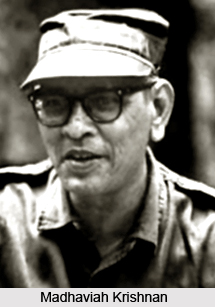 Madhaviah Krishnan or M. Krishnan was a revolutionary Indian wildlife photographer, writer as well as a naturalist. If Gee was an archetype of the Nehru period, M. Krishnan anticipated the conservation agendas of the succeeding phase. He was perhaps alone in his generation of prominent naturalists. After a brief spell as Political Adviser to the rulers of Sandur (near Bellary, Karnataka), he returned to Madras (now Chennai).
Madhaviah Krishnan or M. Krishnan was a revolutionary Indian wildlife photographer, writer as well as a naturalist. If Gee was an archetype of the Nehru period, M. Krishnan anticipated the conservation agendas of the succeeding phase. He was perhaps alone in his generation of prominent naturalists. After a brief spell as Political Adviser to the rulers of Sandur (near Bellary, Karnataka), he returned to Madras (now Chennai).
Early Life of Madhaviah Krishnan
Madhaviah Krishnan was born on 30th of June, 1912 in Tirunelveli. His father was a Tamil writer and reformer and he was the youngest of eight siblings. A botany graduate and lawyer, Madhaviah Krishnan had thorough knowledge of Tamil lore and literature and the mores of the south Indian countryside. M. Krishnan studied in Hindu High School and developed a keen interest in art, literature and nature. His family inhabited in Mylapore, and in those days it was completely covered in shrub. Madhaviah Krishnan joined the Presidency College in the year 1927 and graduated in 1931. He took keen interest in botany.
Professional Life of Madhaviah Krishnan
For a while Madhaviah Krishnan earned a living by writing in some small magazines and publishing his caricatures and drawings. Initially, he also wrote in various Tamil magazines. In the year 1942, M. Krishnan was offered employment by Maharaja of Sandur. He took up the job and his job included being a judge, publicity officer, school teacher and a political secretary to Maharaja. It was from around late 1950s that he began his ascent to the status of the most noted chronicler of India`s wildlife in his times. The word chronicler or historiographer is used deliberately, for he primarily wrote in the popular press, soon winning respect for his wide-ranging observations of human impact on nature. This yielded him a Nehru Fellowship in 1965 and led him on to the preparation of his magnum opus, India`s Wildlife, 1959-1970. In the following years, his work encompassed a larger canvas than that of his fellow naturalists, with Krishnan trying to work out how to retain as large a representative spectrum of the diverse flora and fauna of the newly independent country as was possible.
Contributions of Madhaviah Krishnan
It was as a journalist and self-financed researcher and naturalist that Krishnan made his mark. His first article, published in August 1938, was on a common though little noticed creature, the flying fox. He was an incisive observer of the changes in 1950s rural India. As a young man, he witnessed the rapid disappearance of blackbuck herds across great expanses of the countryside from a mix of factors including hunting for the meat market, competition with domestic goats for forage and conversion of the blackbucks` grassland homes into cultivated fields. He was an ecological patriot. In the meanwhile, M. Krishnan wrote urgently that big dam projects were rapidly depleting forests, with large stretches lost by submergence.
He critically assessed the impact on wildlife of the sweeping economic and social changes underway. He came down heavily on the conversion of natural mixed species forests into single-species plantations of eucalyptus. Krishnan diagnosed the allocation of forests as a state subject as opposed to a federal one as the root cause of the crisis in conservation. Krishnan made no distinction between governmentally sanctioned or elite-inspired deforestation and the conflict between wildlife and cash-poor local users. Many years of observation had led Madhaviah Krishnan to his conclusions, but it was only in the late 1960s that he found ears receptive to his message. The first two decades had been a time when a few scientists and many self-taught naturalists tried to check negative impacts on the living landscape.
Madhaviah Krishnan was given the Padma Shri Award by the Government of India in the year 1969. Madhaviah Krishnan also used photography along with poetry and drawing as another medium for expression. M. Krishnan died on 18th of February, 1996.



















